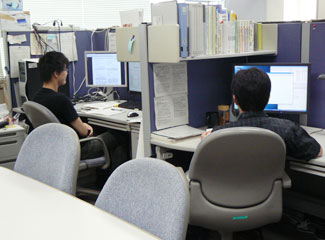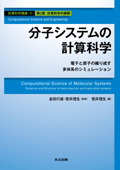| [Site Map][Japanese][English] |
-
Student Recruitment
-
Project
- Computational Science
- Nonequilibrium Systems
- Chemical Reactions
- Macroscopic Chemical Phenomena
- Life Phenomena
- Multiscale Information Processing
- Industry Applications
- Meetings
- FY 2022
- FY 2021
- FY 2020
- FY 2019
- FY 2018
- FY 2017
- FY 2016
- FY 2015
- FY 2014
- FY 2013
- FY 2012
- FY 2011
- FY 2010
- FY 2009
- FY 2008
- FY 2007
- FY 2006
- FY 2005
- FY 2004
- FY 2003
- FY 2000
- FY 2019
- FY 2018
- FY 2017
- FY 2016
- FY 2015
- FY 2014
- FY 2013
- FY 2012
- FY 2011
- FY 2010
- FY 2009
- FY 2008
- FY 2007
- FY 2004-2006
- FY 2003
ConceptResearchesMeetings & Seminars
Open Seminars
References
Facilities
-
People
- Staff
- PostDocs & Students
- OB & OG
- OB & OG Messages
- FY 2018-
- FY 2015-2017
- FY 1999-2014
MembersSnapshots -
Access
-
Link
Computational Sciencing Materials Transformation! -Theoretical Understanding & Visual Understanding-
Research Background and Outline
 We have been studying the frontiers of computational science in "'chemical' reaction dynamics", theoretically
and visually.
We have been studying the frontiers of computational science in "'chemical' reaction dynamics", theoretically
and visually.
While the word "chemistry" might bring to mind images of a 'laboratory', 'white robe', and 'flasks', one major
field of today's computational science is occupied with such "chemistry," which seems at a glance to be quite
irrelevant to computers. In fact, computational chemistry and theoretical chemistry, promoted by high use of
"computer technology", are traditional in the world-class research conducted in Japan. This can be partially
recognized from the Nobel Prize in Chemistry awarded to Kenichi Fukui in 1981 for the 'Frontier Electron
Theory'.
Under the circumstances, in our lab, we are aiming at clarifying unknown chemical phenomena with developing
some new computational scientific methods which are able to deal with "time-dependent and statistical
characteristics", in addition to today's elaborate quantum chemical methods.
。
Research themes
There are mainly two approaches in computational science of chemical reactions. One is the "chemical
kinetics" approach. It determines the reaction mechanism of the product experimentally obtained and designs the
reaction mechanism to obtain the product that is to be newly synthesized. This is done by establishing,
according to the expected reaction mechanism, simultaneous differential equations concerning several kinds of
densities of a molecular species (e.g., molecular number density or partial pressure, etc.) and then solving
them. It can be said that this is an approach which is experimentally oriented to reproduce an experimental
value such as the yield.
The other approach is the "quantum chemistry" approach that treats the molecule from the microscopic viewpoint
and deals with the cleavage and the formation of chemical bonds that take place during the reaction from an
atomic level. From this standpoint, the purpose is to understand the molecular structure of the product and the
rearrangement mechanism of such atoms under the reaction, by determining a molecular chemical reaction at the
atomic level, and connecting it to a new molecular synthetic design. Essentially, although a chemical phenomenon
that happens in a test tube is unique, there are now two approaches according to the difference in standpoint.
In our laboratory we have been working mainly with the latter, and we have been promoting computational
scientific research on material chemical reaction dynamics in condensed systems (i.e., such molecular aggregates
as liquids or solids) on the basis of the techniques of quantum and theoretical chemistry. In 1991, we
advocated the "chemical reaction" molecular dynamics method, which was not yet known worldwide, and developed
the technique of incorporating the microsolvent effect and nonequilibrium nature from the first principle.
Moreover, we developed the "molecular frictional theory" using a molecular hamiltonian, which was established on
the basis of the electronic state theoretical information, and enabled us to consider the origin of a frictional
phenomenon in molecular terms, i.e., intramolecular or intermolecular interactions. Furthermore, we developed
the "free energy gradient method" as a structure optimization method for a solvated or adsorbed molecule, and
succeeded for the first time in the full optimization of the transition state structure of a Menshutkin reaction
in solution, paving the way for wide use.
Future and dreams
Recently, a number of ultra-fast chemical phenomena on the sub-pico to femto-second scale have come to be quantitatively observed experimentally. On the other hand, both "supercomputers and networking techniques" have enabled us to execute "ab initio" multi-scale simulations of complex materials phenomena. Now, we are aiming at constructing some computational scientific methodologies that enable us to understand such super-degrees-of- freedom material systems with an atomic resolution, which can be observed experimentally, and that lead to the microscopic elucidation of (i) "nonequilibrium phenomena" and (ii) an understanding "life phenomena". We are also dreaming of constructing some new theoretical methods to understand "them" continuously making a connection between the first "chemical kinetics" approach and the second "quantum chemistry" one in future.



